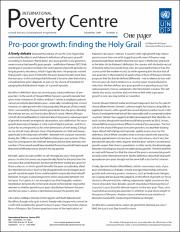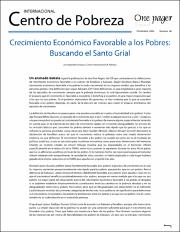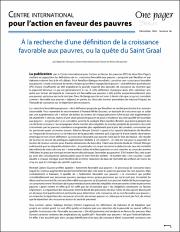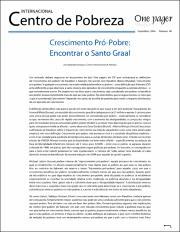Please use this identifier to cite or link to this item:
https://repositorio.ipea.gov.br/handle/11058/15597Files in This Item:
| File | Description | Size | Format | |
|---|---|---|---|---|
| en_IPCOnePager6.pdf | 424.13 kB | Adobe PDF |  View/Open | |
| es_IPCOnePager6.pdf | 64.25 kB | Adobe PDF |  View/Open | |
| fr_IPCOnePager6.pdf | 70.14 kB | Adobe PDF |  View/Open | |
| pt-br_IPCOnePager6.pdf | 65.05 kB | Adobe PDF |  View/Open |
| Title: | Pro-poor growth: finding the Holy Grail |
| Other Titles: | Crecimiento Económico Favorable a los Pobres: Buscando el Santo Grial À la recherche d’une définition de la croissance favorable aux pauvres, ou la quête du Saint Graal Crescimento Pró-Pobre: Encontrar o Santo Graal |
| Authors: | Ginspun, Alejandro |
| Abstract: | A lively debate followed the release of two IPC One Pagers that contrasted Ravallion’s and Kakwani’s definitions of ‘pro-poor growth’. According to Ravallion (World Bank), ‘pro-poor growth’ is any growth in mean income that benefits poor people – a definition Kakwani (IPC) finds wanting as it would encompass the vast majority of growth episodes so long as poverty decreases, which it typically does. He proposes instead that growth is pro-poor if it benefits the poor proportionally more than the non-poor. In the exchange that followed, it became clear that what is considered ‘pro-poor’ depends, in part, on the choice of standards for gauging the distributional impact of a growth episode. (...) Um animado debate seguiu-se ao lançamento de dois One pagers do CIP que contrastava as definições |
| metadata.dc.rights.holder: | International Policy Centre for Inclusive Growth United Nations Development Programme |
| metadata.dc.rights.license: | O texto e dados desta publicação podem ser reproduzidos desde que as fontes sejam citadas. Reproduções com fins comerciais são proibidas. |
| metadata.dc.type: | One Pager |
| Appears in Collections: | Publicações do IPC-IG |
Items in DSpace are protected by copyright, with all rights reserved, unless otherwise indicated.

